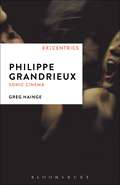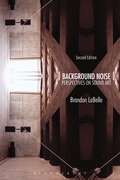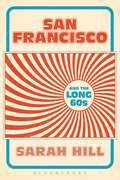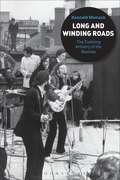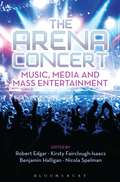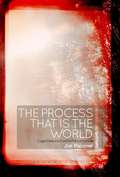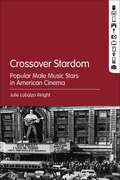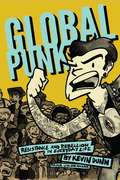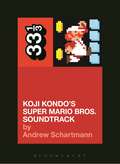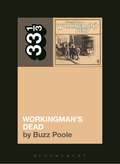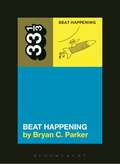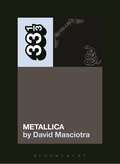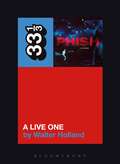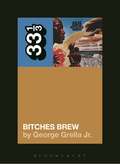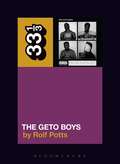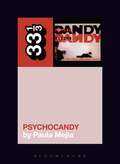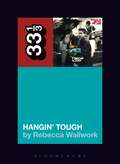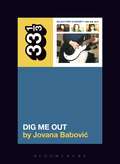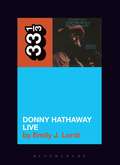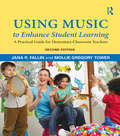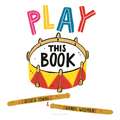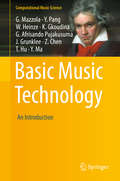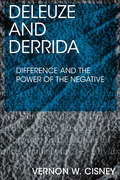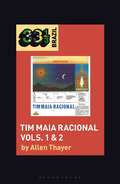- Table View
- List View
Philippe Grandrieux: Sonic Cinema (EX:CENTRICS)
by Greg HaingePhilippe Grandrieux is one of cinema's only living true radicals and feted as one of the most innovative and important film makers of his generation. His consistently controversial work remains, however, relatively unknown outside of the international art film festival circuit. In this volume, the first book-length study of the work of Grandrieux in any language, Greg Hainge provides an overview and critical analysis of Grandrieux's entire career during which he has produced works for television, video installations, photography, performance pieces, documentary films, short films and prize-winning feature films. As well as providing an overview, the book argues that a critical appraisal of his work necessarily leads us to problematize many of the critical orthodoxies that have been formed in recent times, to reject the concept of a haptic cinema and to supplant this instead with the idea of a sonic cinema.
Background Noise, Second Edition: Perspectives on Sound Art
by Brandon LaBelleBackground Noise follows the development of sound as an artistic medium and illustrates how sound is put to use within modes of composition, installation, and performance. While chronological in its structure, Brandon LaBelle's book is informed by spatial thinking - weaving architecture, environments, and the specifics of location into the work of sound, with the aim of formulating an expansive history and understanding of sound art. At its center the book presupposes an intrinsic relation between sound and its location, galvanizing acoustics, sound phenomena, and the environmental with the tensions inherent in what LaBelle identifies as sound's relational dynamic. For the author, this is embedded within sound's tendency to become public expressed in its ability to travel distances, foster cultural expression, and define spaces while being radically flexible.This second expanded edition includes a new chapter on the non-human and subnatural tendencies in sound art, revisions to the text as well as a new preface by the author. Intersecting material analysis with theoretical frameworks spanning art and architectural theory, performance studies and media theory, Background Noise makes the case that sound and sound art are central to understandings of contemporary culture.
San Francisco and the Long 60s
by Sarah HillSan Francisco and the Long 60s tells the fascinating story of the legacy of popular music in San Francisco between the years 1965-69. It is also a chronicle of the impact this brief cultural flowering has continued to have in the city – and more widely in American culture – right up to the present day. The aim of San Francisco and the Long 60s is to question the standard historical narrative of the time, situating the local popular music of the 1960s in the city's contemporary artistic and literary cultures: at once visionary and hallucinatory, experimental and traditional, singular and universal. These qualities defined the aesthetic experience of the local culture in the 1960s, and continue to inform the cultural and social life of the Bay Area even fifty years later.The brief period 1965-69 marks the emergence of the psychedelic counterculture in the Haight-Ashbury neighbourhood, the development of a local musical 'sound' into a mainstream international 'style', the mythologizing of the Haight-Ashbury as the destination for 'seekers' in the Summer of Love, and the ultimate dispersal of the original hippie community to outlying counties in the greater Bay Area and beyond. San Francisco and the Long 60s charts this period with the references to received historical accounts of the time, the musical, visual and literary communications from the counterculture, and retrospective glances from members of the 1960s Haight community via extensive first-hand interviews.For more information, read Sarah Hill's blog posts here:http://blogs.cardiff.ac.uk/musicresearch/2014/05/15/san-francisco-and-the-long-60shttp://blogs.cardiff.ac.uk/musicresearch/2014/08/22/city-scale/http://blogs.cardiff.ac.uk/musicresearch/2015/07/21/fare-thee-well/
Long and Winding Roads: The Evolving Artistry of the Beatles
by Kenneth WomackIn Long and Winding Roads: The Evolving Artistry of the Beatles, Kenneth Womack brings the band's story vividly to life-from their salad days as a Liverpool Skiffle group and their apprenticeship in the nightclubs and mean streets of Hamburg through their early triumphs at the legendary Cavern Club and the massive onslaught of Beatlemania itself. By mapping the group's development as an artistic fusion, Womack traces the Beatles' creative arc from their first, primitive recordings through Abbey Road and the twilight of their career.In order to communicate the nature and power of the band's remarkable achievement, Womack examines the Beatles' body of work as an evolving art object. He investigates the origins and creation of the group's compositions, as well as the songwriting and recording practices that brought them to fruition. Womack's analysis of the Beatles' albums transports readers on a journey through the Beatles' heyday as recording artists between 1962 and 1969, when the band enjoyed a staggering musical and lyrical leap that took them from their first album Please Please Me, which they recorded in the space of a single day, to Sgt. Pepper's Lonely Hearts Club Band, the White Album, and Abbey Road-albums that collectively required literally thousands of hours to produce. In addition to considering the band's increasing self-consciousness about the overall production, design, and presentation of their art, Womack explores the Beatles' albums as a collection of musical and lyrical impressions that finds them working towards a sense of aesthetic unity. In Long and Winding Roads, Womack reveals the ways in which the Beatles gave life to a musical synthesis that would change the world.
The Arena Concert: Music, Media and Mass Entertainment
by Robert Edgar Benjamin Halligan Nicola Spelman Kirsty FaircloughThe Arena Concert: Music, Media and Mass Entertainment is the first sustained engagement with what might said to be - in its melding of concert and gathering, in its evolving relationship with digital and social media, in its delivery of event, experience, technology and star - the art form of the 21st century. This volume offers interviews with key designers, discussions of the practicalities of mounting arena concerts, mixing and performing live to a mass audience, recollections of the giants of late twentieth century music in performance, and critiques of latter-day pretenders to the throne. The authors track the evolution of the arena concert, consider design and architecture, celebrity and fashion, and turn to feminism, ethnographic research, and ideas of humour, liveness and authenticity, in order to explore and frame the arena concert. The arena concert becomes the “real time” centre of a global digital network, and the gig-goer pays not only for an immersion in (and, indeed, role in) its spectacular nature, but also for a close encounter with the performers, in this contained and exalted space. The spectacular nature of the arena concert raises challenges that have yet to be fully technologically overcome, and has given rise to a reinvention of what live music actually means.Love it or loathe it, the arena concert is a major presence in the cultural landscape of the 21st century. This volume finds out why.
The Process That Is the World: Cage/Deleuze/Events/Performances
by Joe PanznerThe Process That Is the World grapples with John Cage not just as a composer, but as a philosopher advocating for an ontology of difference in keeping with the kind posited by Gilles Deleuze. Cage's philosophy is not simply a novel method for composition, but an extensive argument about the nature of reality itself, the construction of subjects within that reality, and the manner in which subjectivity and a self-creative world exist in productive tension with one another. Over the course of the study, these themes are developed in the realms of the ontology of a musical work, performance practices, ethics, and eventually a study of Cagean politics and the connection between aesthetic experience and the generation of new forms of collective becoming-together. The vision of Cage that emerges through this study is not simply that of the maverick composer or the "inventor of genius,†? but of a thinker and artist responding to insights about the world-as-process as it extends through the philosophical, artistic, and ethical registers: the world as potential for variance, reinvention, and permanent revolution.
Crossover Stardom: Popular Male Music Stars in American Cinema
by Julie Lobalzo WrightCrossover Stardom: Popular Male Stars in American Cinema focuses on male music stars who have attempted to achieve film stardom. Crossover stardom can describe stars who cross from one medium to another. Although 'crossover' has become a popular term to describe many modern stars who appear in various mediums, crossover stardom has a long history, going back to the beginning of the cinema. Lobalzo Wright begins with Bing Crosby, a significant Hollywood star in the studio era; moving to Elvis Presley in the 1950s and 1960s, as the studio system collapsed; to Kris Kristofferson in the New Hollywood period of the 1970s; and ending with Will Smith and Justin Timberlake, in the contemporary era, when corporate conglomerates dominate Hollywood. Thus, the study not only explores music stardom (and music genres) in various eras, and masculinity within these periods, it also surveys the history of American cinema from industrial and cultural perspectives, from the 1930s to today.
Global Punk: Resistance and Rebellion in Everyday Life
by Kevin DunnGlobal Punk examines the global phenomenon of DIY (do-it-yourself) punk, arguing that it provides a powerful tool for political resistance and personal self-empowerment. Drawing examples from across the evolution of punk – from the streets of 1976 London to the alleys of contemporary Jakarta – Global Punk is both historically rich and global in scope. Looking beyond the music to explore DIY punk as a lived experience, Global Punk examines the ways in which punk contributes to the process of disalienation and political engagement. The book critically examines the impact that DIY punk has had on both individuals and communities, and offers chapter-length investigations of two important aspects of DIY punk culture: independent record labels and self-published zines. Grounded in scholarly theories, but written in a highly accessible style, Global Punk shows why DIY punk remains a vital cultural form for hundreds of thousands of people across the globe today.
Koji Kondo's Super Mario Bros. Soundtrack (33 1/3)
by Andrew SchartmannKoji Kondo's Super Mario Bros. (1985) score redefined video game music. With under three minutes of music, Kondo put to rest an era of bleeps and bloops-the sterile products of a lab environment-replacing it with one in which game sounds constituted a legitimate form of artistic expression. Andrew Schartmann takes us through the various external factors (e.g., the video game crash of 1983, Nintendo's marketing tactics) that coalesced into a ripe environment in which Kondo's musical experiments could thrive. He then delves into the music itself, searching for reasons why our hearts still dance to the "primitive†? 8-bit tunes of a bygone era.What musical features are responsible for Kondo's distinct "Mario sound†?? How do the different themes underscore the vastness of Princess Peach's Mushroom Kingdom? And in what ways do the game's sound effects resonate with our physical experience of the world? These and other questions are explored within, through the lens of Kondo's compositional philosophy-one that would influence an entire generation of video game composers. As Kondo himself stated, "we [at Nintendo] were trying to do something that had never been done before.†? In this book, Schartmann shows his readers how Kondo and his team not just succeeded, but heralded in a new era of video games.
Grateful Dead's Workingman's Dead (33 1/3)
by Buzz PooleReleased in 1970, Workingman's Dead was the breakthrough album for the Grateful Dead, a cold-water-shock departure from the Acid Test madness of the late '60s. It was the band's most commercially and critically successful release to date. More importantly, these songs established the blueprint for how the Dead would maintain and build upon a community held together by the core motivation of rejecting the status quo – the "straight life†? – in order to live and work on their own terms. As a unified whole, the album's eight songs serve as points of entry into a fully-rendered portrait of the Grateful Dead within the context of late twentieth-century American history. These songs speak to the attendant cultural and political anxieties that resulted from the idealism of the '60s giving way to the uncomfortable realities of the '70s, and the band's evolving perspective on these changes. Based on research, interviews, and personal experience, this book probes the paradox at the heart of the band's appeal: the Grateful Dead were about much more than music, though they were really just about the music.
Beat Happening's Beat Happening (33 1/3)
by Bryan C. ParkerThis is the album that sent a shockwave of empowerment through the nation's cultural underground. In 1985, Olympia, Washington band Beat Happening released their eponymous debut of lo-fi pop songs on K Records and challenged every conception held about music. At the center of the group was the enigmatic Calvin Johnson and his revolutionary vision of artistic creation. His foresight and industriousness allowed him to recruit to the K Records roster other free-spirited artists like Beck, Modest Mouse, and Built to Spill long before they gained widespread acclaim.This book, structured in abecedarian fashion, breaks down the fundamental components that defined Beat Happening's self-titled album. With a foreword by Phil Elverum, it's organized in a light-hearted yet incisive format, each of the book's chapters details a particular facet of the record-band members, historic shows, recording sessions, songs, and ideologies-parts reflecting the album as a whole. These alphabetic ingredients constitute a recipe book for feeding your creative spirit.Here is the story of a band that popularized do-it-yourself projects and home recording with four-track tape machines decades before the digital revolution would extend an open hand to garage bands everywhere. This is the story of musical pioneers. This is Beat Happening.
Metallica's Metallica (33 1/3)
by David MasciotraIn 1991, Metallica released their fifth studio album that would become known and beloved around the world as "The Black Album.†? Since its release, it has sold 30 million copies, and become a towering monument in the pantheon of rock's greatest records. Readers will get unprecedented insight into the story behind an iconic album from one of the world's most iconic bands through interviews with James Hetfield, Lars Ulrich, Kirk Hammett, Jason Newsted, and "Black Album†? producer Bob Rock. Masciotra takes readers into the recording studio, giving them Metallica's account of how their most successful and famous record was born and learned to walk into every radio station and stadium stage around the world. Masciotra not only talks to the band about the making of the album, but also the stories that inspired the songs. Readers will not only learn about "The Black Album,†? but they will also gain greater knowledge and familiarity with the men who created it. With direct access to the band, Masciotra offers a fascinating and inspiring account of the creation of one of music's best and best-selling albums.
Phish's A Live One (33 1/3)
by Walter HollandTwenty years after its release, Phish's double-CD collection A Live One has something rare and precious going for it: it still doesn't sound like anybody else. Oversized, perverse, requiring an unusual amount of listener background knowledge? Yes to all. Yet the collective improvisations it captures, unprecedentedly coherent yet freewheeling and open-ended, are unique in rock 'n' roll.This book considers the music and moment of Phish's ecstatically inventive 1995 live document, a mix of weirdo acid-psych, ambient moonscapes, vaudevillian Americana, and riotous arena-rock energy, all filtered through bandleader Trey Anastasio's screwball compositional sensibility and the band's idiosyncratic approach to spontaneous group creativity. It places Phish and their fandom in historical and cultural context, and picks apart the mechanics of their extended group jams. And it examines the mystery of how a quartet of nice boys from Burlington, VT could have been, all at once, one of America's biggest touring acts and one of its best-kept secrets.
Miles Davis' Bitches Brew (33 1/3)
by George GrellaIt was 1969, and Miles Davis, prince of cool, was on the edge of being left behind by a dynamic generation of young musicians, an important handful of whom had been in his band. Rock music was flying off in every direction, just as America itself seemed about to split at its seams. Following the circumscribed grooves and ambiance of In A Silent Way; coming off a tour with a burning new quintet-called 'The Lost Band'-with Wayne Shorter, Chick Corea, Dave Holland and Jack DeJohnette; he went into the studio with musicians like frighteningly talented guitarist John McLaughlin, and soulful Austrian keyboardist Joe Zawinul. Working with his essential producer, Teo Macero, Miles set a cauldron of ideas loose while the tapes rolled. At the end, there was the newly minted Prince of Darkness, a completely new way forward for jazz and rock, and the endless brilliance and depth of Bitches Brew.Bitches Brew is still one of the most astonishing albums ever made in either jazz or rock. Seeming to fuse the two, it actually does something entirely more revolutionary and open-ended: blending the most avant-garde aspects of Western music with deep grooves, the album rejects both jazz and rock for an entirely different idea of how music can be made.
Geto Boys' The Geto Boys (33 1/3)
by Rolf PottsAt the outset of summer in 1990, a Houston gangsta rap group called the Geto Boys was poised to debut its self-titled third album under the guidance of hip-hop guru Rick Rubin. What might have been a low-profile remix release from a little-known corner of the rap universe began to make headlines when the album's distributor refused to work with the group, citing its violent and depraved lyrics. When The Geto Boys was finally released, chain stores refused to stock it, concert promoters canceled the group's performances, and veteran rock critic Robert Christgau declared the group "sick motherfuckers." One quarter of a century later the album is considered a hardcore classic, having left an immutable influence on gangsta rap, horrorcore, and the rise of Southern hip-hop. Charting the rise of the Geto Boys from the earliest days of Houston's rap scene, Rolf Potts documents a moment in music history when hip-hop was beginning to replace rock as the transgressive sound of American youth. In creating an album that was both sonically innovative and unprecedentedly vulgar, the Geto Boys were accomplishing something that went beyond music. To paraphrase a sentiment from Don DeLillo, this group of young men from Houston's Fifth Ward ghetto had figured out the "language of being noticed" - which is, in the end, the only language America understands.
The Jesus and Mary Chain's Psychocandy (33 1/3)
by Paula MejiaThe Jesus and Mary Chain's swooning debut Psychocandy seared through the underground and through the pop charts, shifting the role of noise within pop music forever. Post-punk and pro-confusion, Psychocandy became the sound of a generation poised on the brink of revolution, establishing Creation Records as a tastemaking entity in the process. The Scottish band's notorious live performances were both punishingly loud and riot-spurring, inevitably acting as socio-political commentary on tensions emergent in mid-1980s Britain. Through caustic clangs and feedback channeling the rage of the working-class who'd had enough, Psychocandy gestures toward the perverse pleasure in having your eardrums exploded and loudness as a politics within itself. Yet Psychocandy's blackened candy heart center – calling out to phantoms Candy and Honey with an unsettling charm – makes it a pop album to the core, and not unlike the sugarcoated sounds the Ronettes became famous for in the 1960s. The Jesus and Mary Chain expertly carved out a place where depravity and sweetness entwined, emerging from the isolating underground of suburban Scotland grasping the distinct sound of a generation, apathetic and uncertain. The irresistible Psychocandy emerged as a clairvoyant account of struggle and sweetness that still causes us to grapple with pop music's relation to ourselves.
New Kids on the Block's Hangin' Tough (33 1/3)
by Rebecca WallworkHangin' Tough, the second album by the New Kids on the Block, has sold more than seventeen million copies worldwide since it was released in 1988. But the album and the band have also been dismissed, derided and deemed uncool by the music establishment. Almost thirty years later, the New Kids still perform the songs from Hangin' Tough.Hundreds of thousands of grown women still flock to their concerts to hear-and go bat-shit crazy for-the songs they first heard when they were teenagers. Is this mere nostalgia or can the science of music help explain the enduring success of Hangin' Tough? What is it about this album that made it so special? Is the music any good or are there other factors at play too?Journalist and New Kids fan Rebecca Wallwork sets out to analyze the quality of Hangin' Tough with the help of music cognition experts, critics, producers and music industry pros. This is not a story about crazy fans, boy bands and truckloads of cheesy merchandise; it is an exploration of a watershed album and moment in pop culture history. It is a glimpse into the brain of not just New Kids fans, but into the minds and hearts of anyone who loves music.
Sleater-Kinney's Dig Me Out (33 1/3)
by Jovana BabovicSleater-Kinney's 1997 album Dig Me Out is built on Corin Tucker and Carrie Brownstein's competing guitars, Janet Weiss's muscular rhythms, and layered vocals that teeter between an urgent, banshee-like vibrato and a lower accompaniment. Dig Me Out was the band's third studio album, but the first one written and recoded with Weiss. It inaugurated Sleater-Kinney into a lineup that would span its two-decade career.This 33 1/3 follows the narrative of Dig Me Out from its inception in Olympia to its recording in Seattle and its reception across the United States. It's anchored in a short period of time – roughly from mid-1996 to mid-1998 – but it encompasses a series of battles over meaning that continued to preoccupy Sleater-Kinney in the coming decades. The band wrestled with the media about how they would be presented to the public, it contended with technicians about how their sound would be heard in clubs, and they struggled with pervasive social hierarchies about how their work would be understood in popular culture. The only instance where the band didn't have to put up much of a fight was when it came to their fans. The acclaim Sleater-Kinney received from their listeners in the late 1990s, and continue to receive today, speaks to a need for icons who challenged normative notions of culture and gender. This story of Dig Me Out chronicles how Sleater-Kinney won the fight to define themselves on their own terms – as women and as musicians – and, in the process, how they redefined the parameters of rock.
Donny Hathaway's Donny Hathaway Live (33 1/3)
by Emily J. LordiIn January of 1979, the great soul artist Donny Hathaway fell fifteen stories from a window of Manhattan's Essex House Hotel in an alleged suicide. He was 33 years old and everyone he worked with called him a genius. Best known for "A Song for You,†? "This Christmas,†? and classic duets with Roberta Flack, Hathaway was a composer, pianist, and singer committed to exploring "music in its totality.†? His velvet melisma and vibrant sincerity set him apart from other soul men of his era while influencing generations of singers and fans whose love affair with him continues to this day.The first nonfiction book about Hathaway, Donny Hathaway Live uses original interviews, archival material, musical analysis, cultural history, and poetry to tell the story of Hathaway's life, from his beginnings as a gospel wonder child to his final years. But its focus is the brutally honest, daringly gorgeous music he created as he raced the clock of mental illness-especially in the performances captured on his 1972 album Donny Hathaway Live. That album testifies to Hathaway's uncanny ability to amplify the power and beauty of his songs in the moment of live performance. By exploring that album, we see how he generated a spiritual experience for those present at his shows, and for those with the privilege to listen in now.
Using Music to Enhance Student Learning: A Practical Guide for Elementary Classroom Teachers
by Jana R. Fallin Mollie Gregory TowerIntegrating musical activities in the elementary school classroom can assist in effectively teaching and engaging students in Language Arts, Science, Math, and Social Studies, while also boosting mental, emotional and social development. However, many elementary education majors fear they lack the needed musical skills to use music successfully. Future elementary school teachers need usable, practical musical strategies to easily infuse into their curriculum. Written for both current and future teachers with little or no previous experience in music, Using Music to Enhance Student Learning, Second Edition offers strategies that are not heavily dependent on musical skills. While many textbooks are devoted to teaching music theory skills, this textbook is dedicated to pedagogy – the actual teaching of music – particularly in those schools without a separate music class in their curriculum. The ultimate goal is for future teachers to provide their elementary school classes with engaging learning experiences. These learning experiences are clearly presented to enable children to acquire knowledge in all subject areas within a joyful, creative environment rich with music activities. New to the second edition are the animated listening maps, more audio tracks, a new guitar unit, expanded coverage in the recorder unit, a connection with visual art and music, expanded activities in American history and math, and updated research and statistics. SPECIAL FEATURES Animated "Listening Maps" help listeners focus on music selections through clear visual representations of sound. Group Activities reinforce the social aspects of music-making, as well as the benefits of collaborative teaching and learning. A thorough integration of music in the curriculum establishes that music is essential in a child’s development, and that the incorporation of music will enhance all other subjects/activities in the classroom. Learning Aids include "Tantalizing Tidbits of Research," which provide the justifications for why these activities are important, as well as "Teaching Tips," and "Thinking It Through" activities. The Using Music Package Streamed listening selections from the Baroque, Classical, Romantic, and Contemporary Periods Get America Singing… Again! Volume 1 (developed in association with the Music Educators National Conference, now NAFME, and other music organizations) with 43 songs that represent America’s varied music heritage of folk, traditional, and patriotic themes Appendices include a songbook with Hispanic folksongs, a recorder music songbook and a guitar unit Companion website hosts various teaching and learning resources ISBN 978-0-367-11067-3 Using Music, Second Edition set includes: ISBN 978-0-415-70936-1 Using Music, Second Edition textbook Get America Singing... Again! Volume 1 songbook ISBN 978-0-429-02487-0 Using Music, Second Edition eBook is the textbok only. The songbook is only available with the print textbook and is not sold separately.
Play This Book
by Jessica Young Daniel WisemanFor fans of Press Here, this new interactive picture book line invites readers to touch and move and "play" with the book.To start our show we need a band--maybe you can lend a hand!There are lots of ways little hands can make music. Each page of this interactive book invites readers to strum the guitar, slide the trombone, crash the cymbals, and more--no instruments required! With a delightful rhyming text and engaging illustrations, this book is full of instruments waiting to share their sounds. The only thing this band needs is YOU! Just use your imagination, turn the pages, and Play This Book!Pair with Pet This Book, another title in this young picture book line that comes printed on heavy-duty card stock pages to stand up to all kinds of play!
Basic Music Technology
by Guerino Mazzola Yan Pang William Heinze Kyriaki Gkoudina Gian Afrisando Pujakusuma Jacob Grunklee Zilu Chen Tianxue Hu Yiqing MaThis is an introduction to basic music technology, including acoustics for sound production and analysis, Fourier, frequency modulation, wavelets, and physical modeling and a classification of musical instruments and sound spaces for tuning and counterpoint. The acoustical theory is applied to its implementation in analogue and digital technology, including a detailed discussion of Fast Fourier Transform and MP3 compression. Beyond acoustics, the book discusses important symbolic sound event representation and software as typically realized by MIDI and denotator formalisms. The concluding chapters deal with globalization of music on the Internet, referring to iTunes, Spotify and similar environments. The book will be valuable for students of music, music informatics, and sound engineering.
Deleuze and Derrida: Difference and the Power of the Negative
by Vernon W. CisneyExamines independent documentary film production in India within a political context
Deleuze and Derrida: Difference and the Power of the Negative
by Vernon W. CisneyA reassessment of the film musical post-2000
Tim Maia's Tim Maia Racional Vols. 1 & 2 (33 1/3 Brazil)
by Allen ThayerAt the height of Tim Maia's soaring fame, he joined a radical, extraterrestrial-obsessed cult and created two plus albums of some of Brazil's-and the globe's-best funk and soul music. This book explores the career of the man often hailed as the James Brown or Barry White of Brazil, and the time of his radical transformation from a musician notorious for hedonistic living to a devoted follower of Manoel Jacinto Coelho's Rational Culture.After suddenly joining Coelho's cult in 1974 (which started first as an offshoot of the mystical Afro-Brazilian religion Umbanda), Maia gave up drugs and alcohol, threw away his material possessions, and released Racional Vols. 1 & 2 in the attempt to convert the entirety of Brazil and the world to the revelation of Rational Culture. Thayer explores this strange, brief, yet incredibly prolific period of Maia's life wherein the reigning soul and funk artist of Brazil produced two albums, an EP, and a recently unearthed tape containing almost another full album of funky jams laced with spiritual content and scripture. For just as quickly as Maia became entranced with Coelho did he become disillusioned with the cult, disavowing and destroying everything having to do with that experience and refusing to speak of it for the rest of his life.33 1/3 Global, a series related to but independent from 33 1/3, takes the format of the original series of short, music-based books and brings the focus to music throughout the world. With initial volumes focusing on Japanese and Brazilian music, the series will also include volumes on the popular music of Australia/Oceania, Europe, Africa, the Middle East, and more.
